1483
Little David
Little David - one of the wonders of the world of the gods of war: despite the much more modest appearance, than, for example, "Shverer Gustav" or "Charles", the mortar still holds the record (914 mm or 36 inches) of the largest caliber among all modern artillery.
During World War II in the US Army often used decommissioned large caliber gun barrels for testing bombs, using a relatively small powder charge by sending them to a distance of several hundred yards, as in the normal discharge of a plane is often too much depended on the weather and the ability crew accurately comply with all test conditions. With the increase in the size of the bombs 9.2- and 12-inch barrel longer suitable for these purposes, in connection with which it was decided to design and build a device known as the Bomb Testing Device T1. It has established itself well enough to apply the idea of using it as an artillery gun: it was expected that the invasion of Japan, the US Army will face a very well protected fortifications - such weapons would be ideal for the destruction of bunkers and fortifications. The project was given in the course of March 1944, and later in October of the same year were started shooting test.
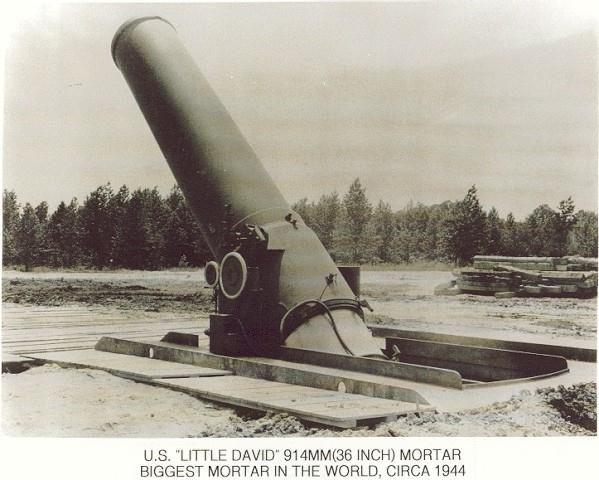
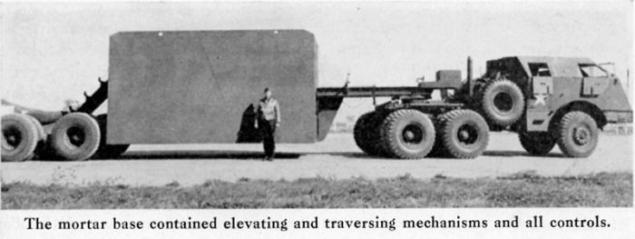
Externally Little David represented the dulnozaryadnuyu mortar with a rifled barrel, based on a large steel box weighing 46, 5 tons, dug a deep pit. Weight of the receiver was 40640 kg. In the box was a mechanism for vertical guidance and 6 hydraulic jacks to insert and remove the stem. The trunk is raised and lowered using the "quadrant" driven from the breech of the barrel, the width of the box allows for horizontal guidance.
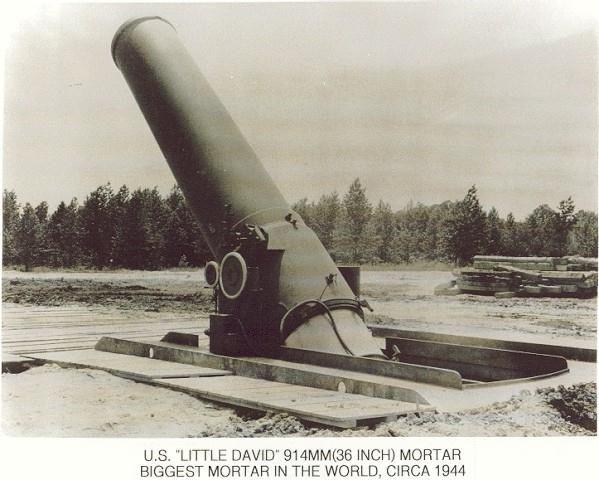
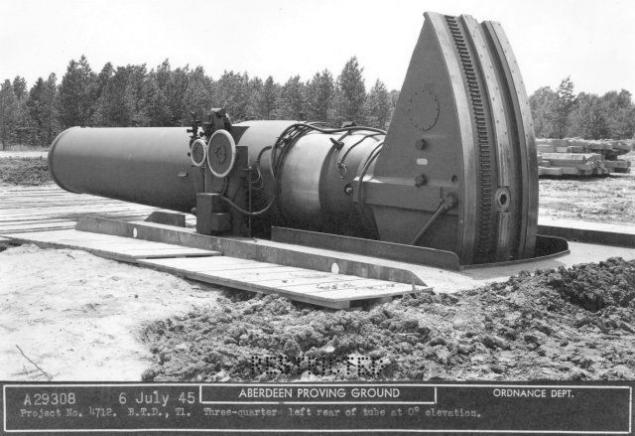
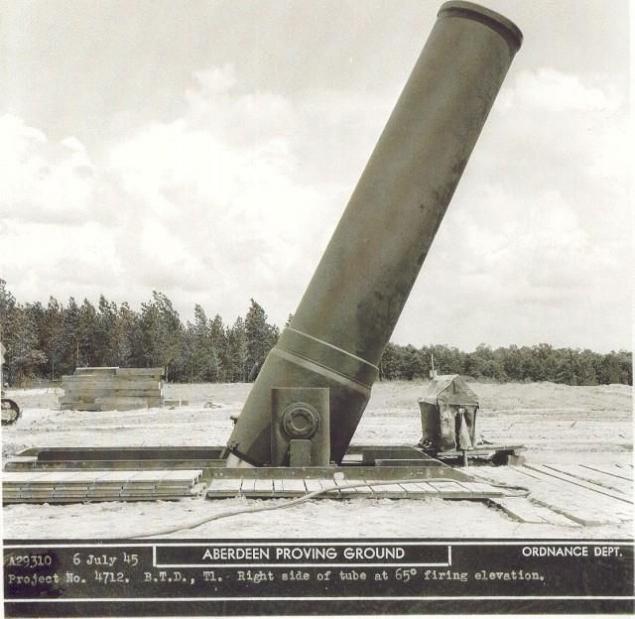
Recuperator absent, trunk manually returned back into position after each shot. The loading was carried out using a special crane.
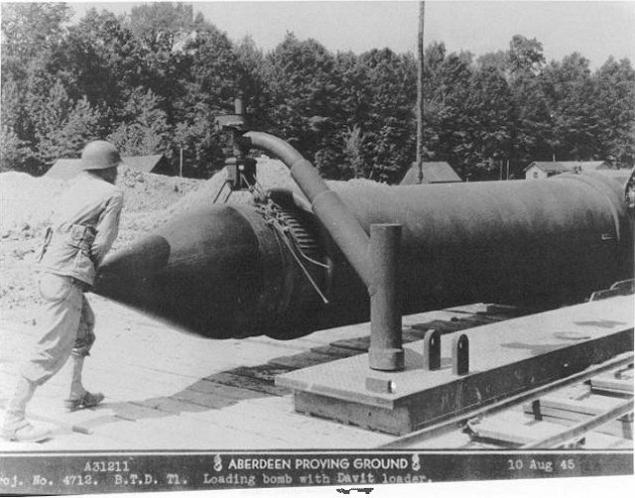
Unique T1-HE shell with a long tapered nose and projections under the rifling of the barrel weighed 1,678 kg (3,700 pounds), of which 726 kg (1600 pounds) accounted for the explosive.
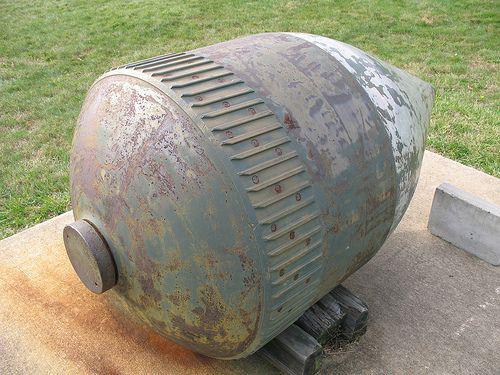
For nearly any purpose such an impact would be devastating (funnel reached 4 m deep and 12 m in diameter), but the mortar was never used in combat conditions - during test firing, it was found that the range (9,500 yards) and accuracy are insufficient. Not inspired and 12 hours required for the installation position (however, the same 800-mm Dora is known to be transported by 25 g / d of platforms and powertrains in readiness for at least 3 weeks). Little David was transported by two artillery tractors (separate receiver part and box-base), which makes it much more mobile w / Dr. guns. The unit also included a bulldozer, crane and bucket excavator equipment for fire position.

Soon after the war ended, the invasion of the Japanese islands was not required, the US Army has frozen work on the stage of development tests. The main disadvantages (range and accuracy) and could not overcome, the project was completely closed in late 1946
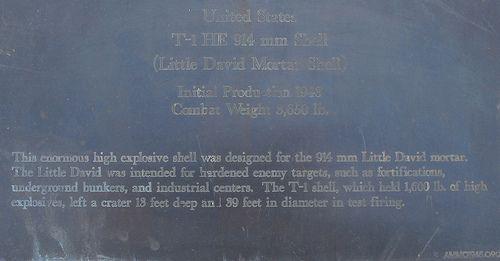
Udo-gun never left Aberdeen Proving Ground, where passed all tests and shooting, and soon became a museum exhibit. Today, it is still part of an extensive exposition of the museum: the trunk and the base resting on wheels conveyors, preserved and one of the unusual shells.
__________________________________________________________________________
Caliber: 914 mm (barrel length - 7120 mm)
The length of the entire receiver: 8534 mm (28 feet)
Full weight with base: 82 808 kg (182,560 lb) [3]
Elevation angles from + 45 ° to + 65 °
Horizontal Guidance: 26 °
Muzzle velocity: 381 m / s (1250 ft / s)
Maximum range: 8687 meters (9500 yards)
Shell weight: 1678 32 kg (3650 pounds)
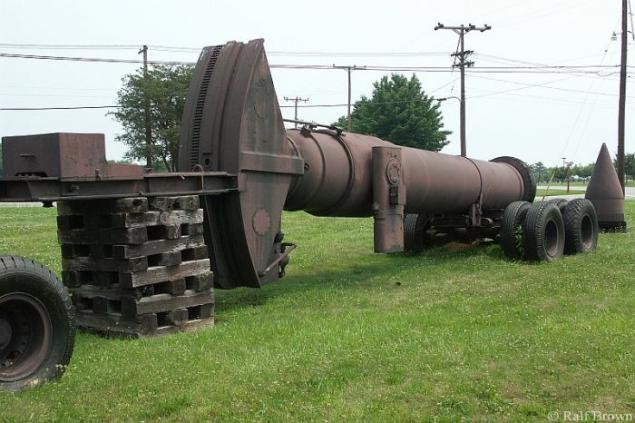
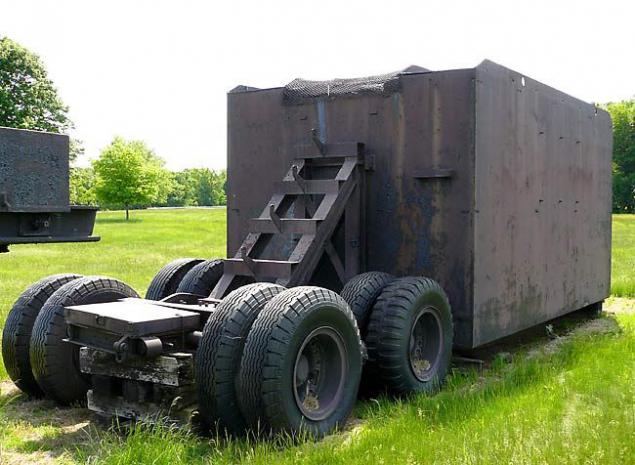


shushpanzer_ru
During World War II in the US Army often used decommissioned large caliber gun barrels for testing bombs, using a relatively small powder charge by sending them to a distance of several hundred yards, as in the normal discharge of a plane is often too much depended on the weather and the ability crew accurately comply with all test conditions. With the increase in the size of the bombs 9.2- and 12-inch barrel longer suitable for these purposes, in connection with which it was decided to design and build a device known as the Bomb Testing Device T1. It has established itself well enough to apply the idea of using it as an artillery gun: it was expected that the invasion of Japan, the US Army will face a very well protected fortifications - such weapons would be ideal for the destruction of bunkers and fortifications. The project was given in the course of March 1944, and later in October of the same year were started shooting test.


Externally Little David represented the dulnozaryadnuyu mortar with a rifled barrel, based on a large steel box weighing 46, 5 tons, dug a deep pit. Weight of the receiver was 40640 kg. In the box was a mechanism for vertical guidance and 6 hydraulic jacks to insert and remove the stem. The trunk is raised and lowered using the "quadrant" driven from the breech of the barrel, the width of the box allows for horizontal guidance.



Recuperator absent, trunk manually returned back into position after each shot. The loading was carried out using a special crane.

Unique T1-HE shell with a long tapered nose and projections under the rifling of the barrel weighed 1,678 kg (3,700 pounds), of which 726 kg (1600 pounds) accounted for the explosive.

For nearly any purpose such an impact would be devastating (funnel reached 4 m deep and 12 m in diameter), but the mortar was never used in combat conditions - during test firing, it was found that the range (9,500 yards) and accuracy are insufficient. Not inspired and 12 hours required for the installation position (however, the same 800-mm Dora is known to be transported by 25 g / d of platforms and powertrains in readiness for at least 3 weeks). Little David was transported by two artillery tractors (separate receiver part and box-base), which makes it much more mobile w / Dr. guns. The unit also included a bulldozer, crane and bucket excavator equipment for fire position.

Soon after the war ended, the invasion of the Japanese islands was not required, the US Army has frozen work on the stage of development tests. The main disadvantages (range and accuracy) and could not overcome, the project was completely closed in late 1946

Udo-gun never left Aberdeen Proving Ground, where passed all tests and shooting, and soon became a museum exhibit. Today, it is still part of an extensive exposition of the museum: the trunk and the base resting on wheels conveyors, preserved and one of the unusual shells.
__________________________________________________________________________
Caliber: 914 mm (barrel length - 7120 mm)
The length of the entire receiver: 8534 mm (28 feet)
Full weight with base: 82 808 kg (182,560 lb) [3]
Elevation angles from + 45 ° to + 65 °
Horizontal Guidance: 26 °
Muzzle velocity: 381 m / s (1250 ft / s)
Maximum range: 8687 meters (9500 yards)
Shell weight: 1678 32 kg (3650 pounds)




shushpanzer_ru
























